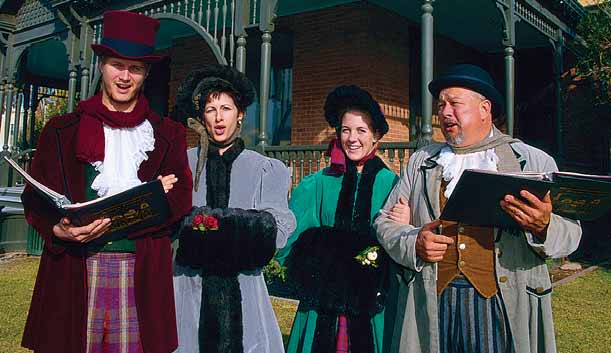DESTINATION Heritage & Science Park

The "children's tree" is decorated, as are each of the bedrooms. Antique toys await in the baby's room; the dolls wear red velvet dresses and sit ready for a tea party in the daughter's room. It might seem like too much at times, with no surface left undone, but then docent Marilyn Estrada jokes, "If it's excessive clutter, it's considered [authentic] Victorian."
A local utility company and handymen string the lights outside the four-gabled house and along other buildings in the square, including several more modern houses moved to this site to save them from destruction. Then the Heritage & Science Park starts celebrating. Docents, in authentic dress and manner, lead "Step Back in Time" tours of the festooned Rosson House, a draw for all the holiday events.
The day after Thanksgiving, a Candyland Concert includes the lighting of the tallest Christmas tree in the state on the square, while children have hands-on activities and a visit with Santa. But the biggest event is the Victorian Holiday Celebration on the second Saturday of December, when the entire square seems transformed into a Victorian village. The Lath House-an open-air pavilion-is filled with arts and crafts, the brick courtyard has food and music, bands play and Victorian carolers stroll through the crowd. Mr. and Mrs. Claus are in attendance, and if you've never tasted chestnuts roasted on an open fire, here's your chance.
The celebration attracts families that find they can span an entire century by visiting the attractions on this one pedestrian square. The Phoenix Museum of History tells the story of a dusty camp that has become the nation's fifth-largest city. Next door rises the Arizona Science Center, devoted to educating children about the wonders of science (although adults also are easily seduced by its interactive exhibits, its giant screen theater and its state-of-the-art planetarium).
Not only do the three main attractions of the square differ in purpose, their architecture gives a quick lesson: The Rosson House includes at least four different styles of architecture popular at the time, from Eastlake to Italianate; the Phoenix Museum of History is a low-slung sweep of glass, while the Arizona Science Center is an exposed concrete modern sculpture.
Also Heritage Square and the museums are among the key attractions in downtown Phoenix. At Christmastime, the Victorian-era Rosson House makes it that much more of a special place to visit. Al LOCATION: Heritage & Science Park, 115 N. Sixth St., Phoenix. The park spans Fifth to Seventh streets between Monroe and Washington streets.
HOURS: Rosson House, Wednesday through Sunday, 10 A.M. to 4 P.M.; Sunday, noon to 4 P.M. Arizona Science Center, open daily, 10 A.M. to 5 P.M., except Thanksgiving Day and Christmas Day. Phoenix Museum of History, Tuesday through Saturday, 10 Α.Μ. to 5 Ρ.Μ.
FEES: Rosson House, $4, adults; $3, seniors and students; $1, children 6 to 12 years; free, 5 and under. Arizona Science Center, $9, adults; $7, children. Phoenix Museum of History, $5, adults; $3.50, seniors, students and military; $2.50, children 7 to 12; free, 6 and under.
EVENTS: November 26, 3 to 8 P.M., Candyland Concert, tree-lighting and photographs with Santa. December 11,10 A.M. to 4 P.M., Victorian Holiday Celebration.
TRAVEL ADVISORY: Two parking garages serve the complex. One is at the southeast corner of Fifth and Monroe streets, the other at the southwest corner ofSeventh and Washington streets.
ADDITIONAL INFORMATION: Rosson House, (602) 2625029, www.rossonhousemuseum.org; Arizona Science Center, (602) 716-2000, www.azscience.org; Phoenix Museum of History, (602) 253-2734, www.pmoh.org.
{hike of the month} Sinagua Indians Made Themselves at Home at Brazaletes Pueblo Ruin
ALL THE ROOMS AT Brazaletes Pueblo Ruin have a view. You can enjoy the sights after a short climb on a good trail leading from Horseshoe Dam Road in the Tonto National Forest 40 miles northeast of Phoenix. Make this a family outing. The reward for following the easy, less-than-a-quarter-mile trail up is a big-sky panorama that takes in the whole Mazatzal Mountains range to the east and a huge chunk of the Verde Valley to the north.
The ruin site straddles a rocky knob of St. Clair Peak, actually little more than a hill at 4,230 feet. Visitors have treated the ruin with respect to preserve its archaeological value. Potsherds and chips from tools still litter the site and are protected by federal law. More than 600 years ago, Sinagua Indians inhabited the structure, which had 70 to 100 rooms and probably served as an outpost along the main trade route along the Verde River to tribal settlements in the north.
St. Clair Spring bubbles from a copse of scrub oak in the shallow valley behind the ruin. A trail about 100 yards south of the ruin parking area leads to the spring with its cowboy bathtub, or swimming hole. This dependable source of water made St. Clair an important stop for ancient people, but the residents probably occupied it only during cooler months. Around mid-May, biting flies called buffalo gnats take over, and summer temperatures prove just too hot.
In early April, Edward H. Steinle of Prescott, Rita Gosnell of Carefree and Madelyn Bell Bales of Imnaha, Oregon, ate a picnic lunch spread out next to a remnant of an unmortared stone wall. The three ride mules together, but that day they were on foot.
But a month later, when Charles and Linda Slinghoff of Scottsdale sat in the same spot, temperatures were steamy. The reservoir had drawn down to nearly empty and has remained dry because of the extended drought. Swarms of gnats probed eyes, noses and mouths for moisture. With their hands waving like windshield wipers, the Slinghoffs tried to chase them away, but the bugs finally won.
"I've had enough," Charles declared, and set off back down the hill.
All To enjoy the Brazaletes Pueblo Ruin, go between late September through April, and don't forget to take a picnic lunch, water, binoculars and a book on Sinagua ruins.
Already a member? Login ».